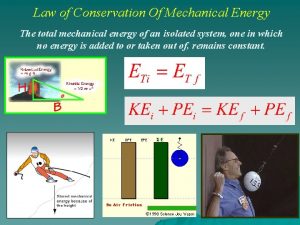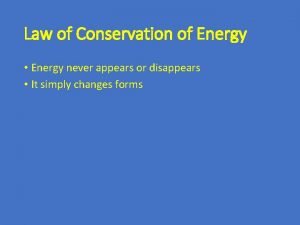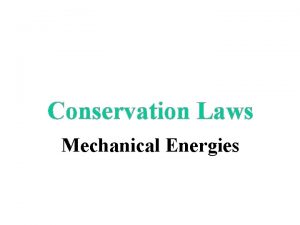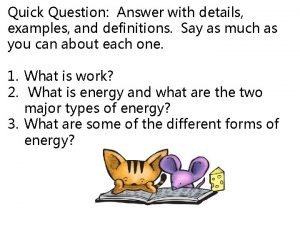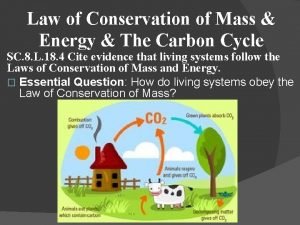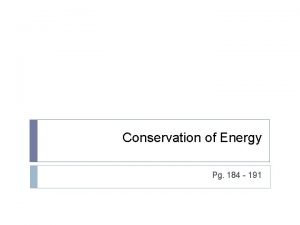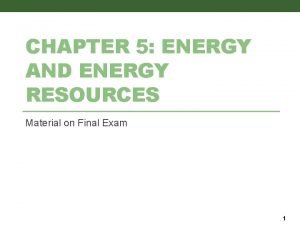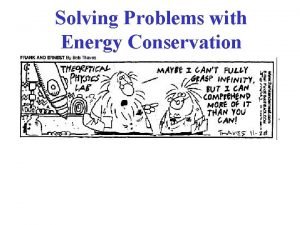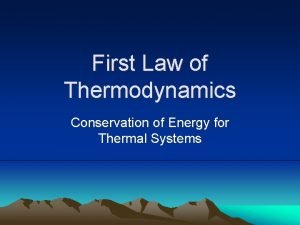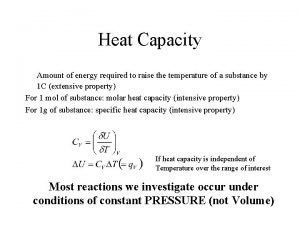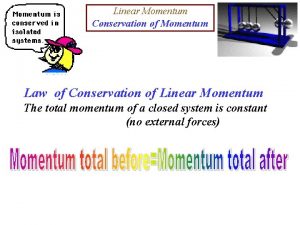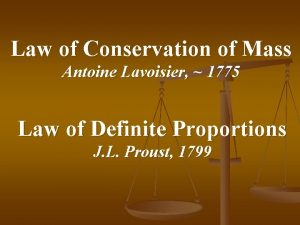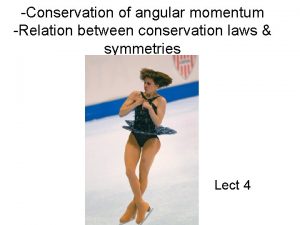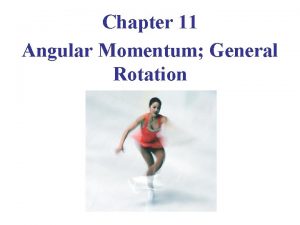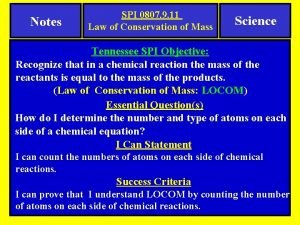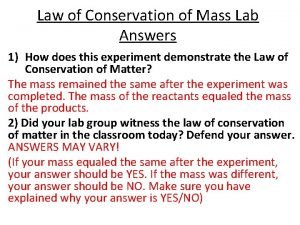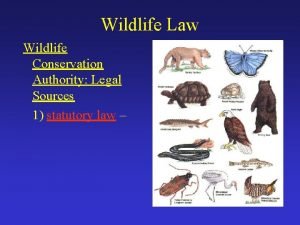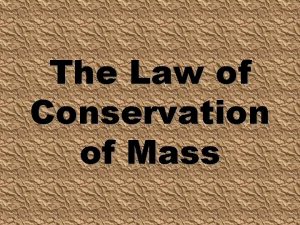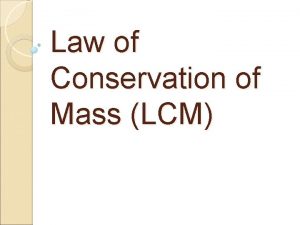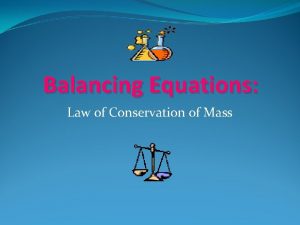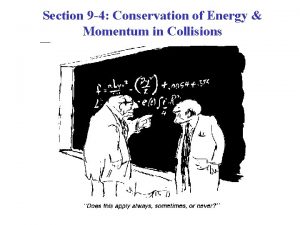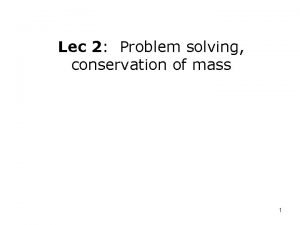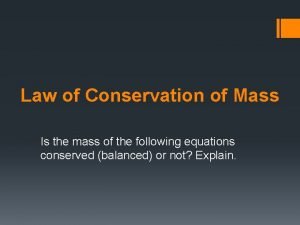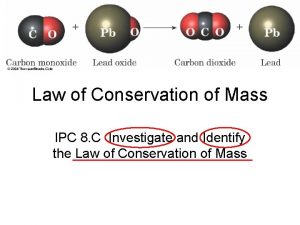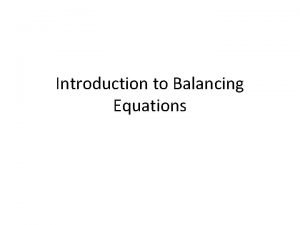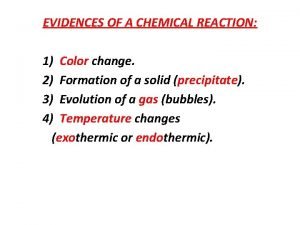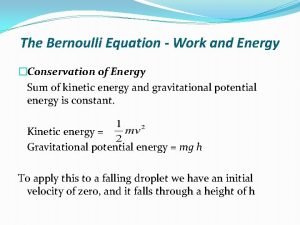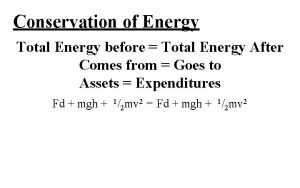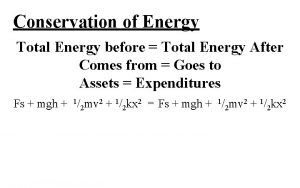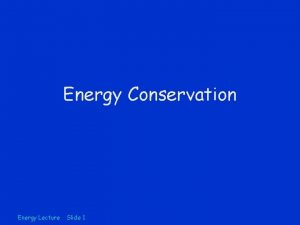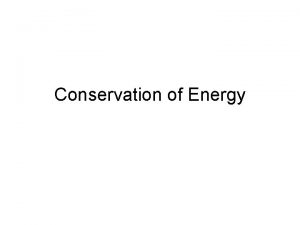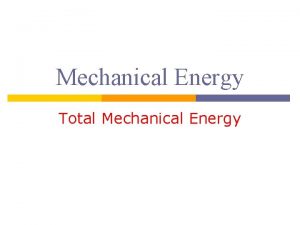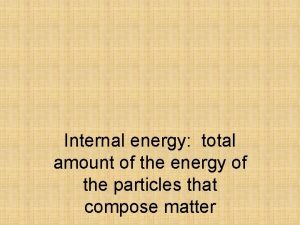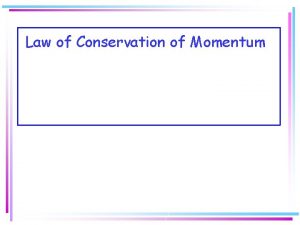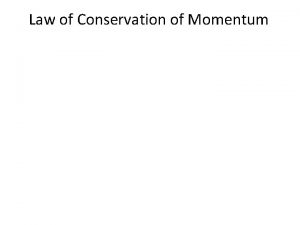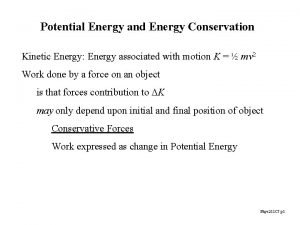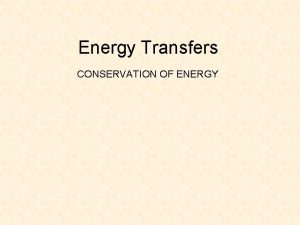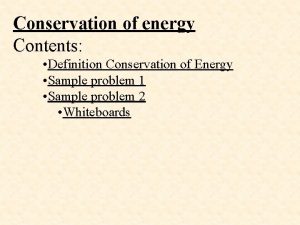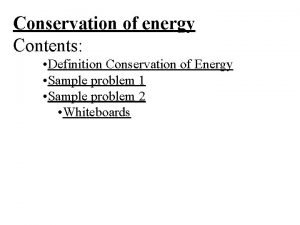Law of Conservation of Energy The total amount
























































- Slides: 56

Law of Conservation of Energy The total amount of energy in the system remains constant • It can only be converted from one form to another BUT • No new energy can be created • It can never be destroyed

Potential and Kinetic Energy • Energy: is the ability to do work

Potential Energy • The energy of position • The amount of energy contained in an object at rest

Determining Potential Energy • By its position and its weight (mass X gravity) PE = (mass)(gravity)(height) = mgh • where m is mass in kg • g is the force of gravity = 9. 8 m/s 2 • h is the height • The SI unit that represents potential energy is the Joule (J) (kg m 2/s 2).

Examine an example of potential energy A flower pot with a mass of 15 kg is sitting on a window sill 15 meters above the ground. How much potential energy does the flower pot contain? • PE = (mass)(gravity)(height) • = (15 kg)(9. 8 m/s 2)(15 m) • = 2205 kg m 2/s 2 • = 2205 J • = 2. 2 x 103 J

Kinetic Energy • SO…. Once force is applied to an object, the object is set into motion. • A moving object is said to contain kinetic energy or energy of motion. • The amount is related to the mass of the object in motion and it’s velocity.

Calculating kinetic energy If we know the mass of an object and its velocity we can determine the amount of kinetic energy possessed by using the following formula: kinetic energy = 1/2 (mass of object)(velocity of object)2 or KE = 1/2 mv 2 or KE = 0. 5 mv 2 The SI unit for kinetic energy is the Joule (J). A Joule is kg m 2/s 2

A bicycle with a mass of 14 kg traveling at a velocity of 3. 0 m/s east has how much kinetic energy? KE = 0. 5 mv 2 = 0. 5(14 kg)(3. 0 m/s)2 = 0. 5(14 kg)(9. 0 m 2/s 2) = 63 kg m 2/s 2 = 63 J


• What type of energy does the space shuttle have at lift off?


Conversion of Potential to Kinetic Energy • In this picture both kinds of energy are evident. Can you point them out?

• The water at the top has potential energy • When water falls to a lower level, the potential energy is converted to kinetic energy.

FORCES • The term force refers to the interaction of objects and their environment. • All forces are exerted on one object by another object. • Forces have both size and direction and are normally classified as “pushes or pulls”. • All forces have both size and direction

Gravity – most familiar force • Gravity is the basic force of attraction that is spread throughout the universe. Gravity pulls objects towards each other. • Gravity on earth pulls you and all objects towards the earth. • You must overcome gravity each time you lift something. • Gravitational force on earth is 9. 8 m/s 2 • Other forces – – Buoyancy – Electricity -Friction -Pressure

Calculating Force The relationship between an object's mass m, its acceleration a, and the applied force F Force =(mass)(acceleration) or F = ma • The SI units force is the Newton (N) A Newton is equivalent to the units: N = kg x m s 2

Example • An object with a mass of 15. 0 kg is moving with an acceleration of 25. 0 m/s 2. What is the force acting on that object? F = ma = (15. 0 kg) x 25. 0 m/s 2) = 375 kg • m/s 2 = 375 N

Another Force - Weight • Weight is a force applied to an object as a result of gravity. • Weight = mass x (gravitational force) Fw = (m) (g) • On earth, the force of gravity is nearly constant = 9. 8 m/s 2

Mass vs. weight Understand the difference

Weight • It is different depending on where the object is located and the amount of gravity acting on it. • Weight is expressed in Newtons (N) • Weight of an object can be determined by the following formula Weight = (mass) (gravity) OR Fw = (m)(g)

Example If an object has a mass of 75 kg on earth, what is it’s weight? Fw = (m)(g) = (75 kg) x (9. 8 m/s 2) = 735 kg • m/s 2 = 735 N = 740 N

Re-Arrange the Formula Solve for weight Fw = (m)(g) Solve for mass m= Fw ÷ (g) Solve for gravity g= Fw ÷ (m)

How Energy Relates to Work Energy - the ability to do work Work - a measure of how productive an applied force is

Work • Work is the product of the force applied to an object time the distance through which the force acts • EXAMPLES OF WORK – Lifting a book – Pulling a cart – Pushing a door open • Sometimes there are easy ways and hard ways to do the same amount of work.

Work • The formula for work is: Work = (force) (distance) or W = Fd The unit for work is the Joule J = N * m = kg *m 2 s 2 It is important that you understand that all units used in the equation are in Kg, m and seconds. The problem will not be accurate (or correct) if the units are not in this form.

Example • A book weighing 3. 0 N is lifted 5 m. How much work is done? W = Fd W = (3. 0 N) (5 m) W = 15 J

You need to rearrange the equation to get force. F=W÷d Rearrange for distance d=w÷F

Using Simple Machines to do Work More Easy Devices that allow us to perform the same amount of work more easily.

Simple Machines Work in One of 3 Ways 1. Can take the force exerted by the individual and redirect it 2. Can turn a small effort or force into a larger force (mechanical advantage) 3. Can magnify the distance that a force acts on Machines do not reduce the amount of work needed to perform a task, they reduce the effort needed from the user.

3 Kinds We Will Consider 1. Lever 2. Inclined Plane 3. Pulley

The Lever • Is a narrow beam that rotates around a single point called the fulcrum • By placing an object to be moved, called the load, at one point on the beam and by applying an effort at another point the object can be moved more easily

1 st Class Lever • 1 st class – where the fulcrum lies between the load and the effort Fulcrum Load Effort


2 nd class lever • 2 nd class levers where the fulcrum lies at one end an effort is placed at the other end. – The load lies in between Fulcrum Load Effort


3 rd Class Lever • 3 rd class lever – where the effort is applied between the load (W) and the fulcrum Fulcrum Effort Load


Review of Levers 1 st Class Lever Load – Fulcrum – Effort 2 nd Class Lever Fulcrum – Load – Effort 3 rd Class Lever Fulcrum – Effort - Load

Formula for Levers Effort X distance from the fulcrum = weight X distance from the fulcrum The ability of the lever to help perform work is dependent on the length of the lever and on the mass applied to the lever. Too heavy of a mass or too long of lever the lever will break.

How much mass can a lever handle? Apparatus for lab looks like this:

Inclined Plane • Device designed to reduce the force needed to raise an object. • For example, pushing a load up a ramp onto a platform requires less force than lifting the load onto the platform. • Ramps and steps are forms of inclined planes.

Screw • Screw is an inclined plane wrapped in a spiral around a shaft.

Wedge • Wedge is actually 2 inclined planes joined back-to-back • The planes exert lateral forces to split the piece of wood

Remember! An inclined plane does not reduce the amount of work being done – It simple reduces the force necessary to complete that work by creating a mechanical advantage.

Pulleys • is a wheel over which a rope or belt is passed for the purpose of transmitting energy and doing work.

Pulleys Reduce the effort to raise an object or it redirects the applied force, depending on the type of pulley.

Velocity & Acceleration Some Review

Defining Velocity Kinetic energy was – KE=1/2 (mass) (velocity)2 • Describes both the rate and direction of the motion • If an object speeds up or slows down in the given direction we say there is a change in velocity

VELOCITY AND SPEED Velocity is a measure of how fast an object is traveling in a certain direction. – Example: A plane moving at 600 mph to the north has a velocity. – Important to realize that for you to use velocity, you must have a direction! – Speed is a measure of how fast something is moving, but there is not a directional element to it.

VELOCITY AND SPEED – Speed is a measure of how fast something is moving, but there is not a directional element to it – Is the distance on object moves per time – Speed = Distance X Time (S=D x T) – If speed changes, so does the velocity

VELOCITY Velocity = distance ÷ time The units we use are m/s and d is distance. Rearranging the formulas for all possibilities: V= d/t d = vt t = d/v

VELOCITY • What is the velocity of a car that travels 100 m in 2 hours? V = d/t 100. m/2 h = 50. 0 m/h A car travels 65. 0 m/h for 3. 00 hours how far did it go? d = vt (65. 0 m/h) (3. 00 h) = 195 m = How long would it take a car to travel 200 miles at a velocity of 70 m/h? t = d/v t = 200 m/70 m/h t = 2. 9 h = 3 hr Make sure you work your problems so that units cancel out.

ACCELERATION • Acceleration is the change in velocity per unit of time. • An example of this is when you travel in your car. • Your velocity is not constant throughout the entire trip as you slow down and speed up as necessary. • A positive acceleration means that you are speeding up and a negative acceleration means that you are slowing down.

ACCELERATION • Acceleration has the formula: Acceleration = (Final Velocity) – (initial velocity) (Final time) – (Initial time) OR (time it takes to change velocity) A = vf – vi = ∆v ∆ means “change in” t f – ti ∆ t Acceleration has the units of (distance unit)/(time unit) Ex: m/s 2 or mi/h 2

ACCELERATION • Example acceleration problems • Calculate the acceleration of an object with: » Initial Velocity : 0. 0 m/s » Final Velocity: 14 m/s » Time 4 s » A = 14 m/s – 0 m/s 4 s A = 3. 5 m/s 2

ACCELERATION • A car stops from a velocity of 55 m/s in 15 seconds. What is the cars acceleration? Is the car speeding up or slowing down? • A = 0 – 55 m/s 15 s A = -3. 7 m/s 2 Car is slowing down -55 m/s 15 s
 Kinetic formula
Kinetic formula Conservation of mechanical energy
Conservation of mechanical energy Law of conservation of energy worksheets
Law of conservation of energy worksheets Energy conservation law
Energy conservation law Law of conservation of energy example
Law of conservation of energy example Energy conservation law
Energy conservation law Law of conservation of mechanical energy
Law of conservation of mechanical energy Grade 7 natural sciences term 3 project
Grade 7 natural sciences term 3 project The law of conservation of energy states that
The law of conservation of energy states that Potential energy vs kinetic energy
Potential energy vs kinetic energy How does the carbon cycle obey the law of conservation
How does the carbon cycle obey the law of conservation Law of conservation of energy
Law of conservation of energy The law of conservation of energy states that
The law of conservation of energy states that How to solve mechanical energy
How to solve mechanical energy Conservation of energy thermodynamics
Conservation of energy thermodynamics Chapter 7 energy conservation of energy
Chapter 7 energy conservation of energy Pyramid of number
Pyramid of number The total amount of an employee's earnings is called
The total amount of an employee's earnings is called What is useful energy
What is useful energy Newton's first law and second law and third law
Newton's first law and second law and third law Newton's first law of motion
Newton's first law of motion Boyles law
Boyles law Charles law constant
Charles law constant The amount of energy required
The amount of energy required Energy energy transfer and general energy analysis
Energy energy transfer and general energy analysis Energy energy transfer and general energy analysis
Energy energy transfer and general energy analysis Momentum means
Momentum means How momentum conservation is applied in vehicular accidents
How momentum conservation is applied in vehicular accidents Law of conservation of momentum animation
Law of conservation of momentum animation Antoine lavoisier law of conservation of mass
Antoine lavoisier law of conservation of mass Law of conservation of angular momentum
Law of conservation of angular momentum Angular momentum units
Angular momentum units Law of conservation od mass
Law of conservation od mass Law of conservation of mass lab worksheet answers
Law of conservation of mass lab worksheet answers Momentum practice problems
Momentum practice problems Wildlife conservation law
Wildlife conservation law Law of conservation of mass
Law of conservation of mass Law of conservation of momentum definition
Law of conservation of momentum definition Law of conservation of matter definition
Law of conservation of matter definition Law of conservation of mass
Law of conservation of mass Law of conservation of mass
Law of conservation of mass Control volume approach
Control volume approach Law of conservation of mass
Law of conservation of mass Conservation of momentum
Conservation of momentum Br3cl9 compound name
Br3cl9 compound name Law of conservation of mass example
Law of conservation of mass example Conservation of mass in chemical reactions
Conservation of mass in chemical reactions Law of conservation of matter
Law of conservation of matter Conservation of mass
Conservation of mass Law of conservation of mass examples
Law of conservation of mass examples Ciclo de servicio de una aerolinea
Ciclo de servicio de una aerolinea Total revenues minus total costs equals
Total revenues minus total costs equals Total revenues minus total costs equals
Total revenues minus total costs equals Total revenues minus total costs equals
Total revenues minus total costs equals Total revenue minus total expenses
Total revenue minus total expenses Final potential energy
Final potential energy A crane lowers a girder into place
A crane lowers a girder into place

